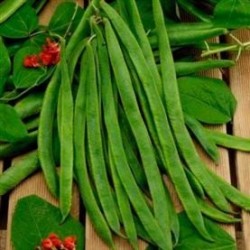



Well established, favourite variety. Excellent crops of smooth textured, 35-40 cm long pods. Great source of Vitamin C and iron.
Runner beans are an easy plant for novice organic gardeners to grow. It is easy to grow runner beans from seeds – even small children can give it a go. When given the right growing conditions, runner beans can be both beautiful and productive. They are the perfect addition to an edible garden when you and your family and relax and unwind and grow food for your table.
Preparing A Growing Area For Runner Beans
One of the main things to remember about runner beans is that they are vining plants that will require some sort of support. How you support your beans is up to you. One of the easiest and most affordable solutions is to create a wigwam or tipi from long, straight branches from your garden or using garden bamboo canes purchased at a local garden centre. You simply tie these branches or canes together at top centre. It is also possible to construct structures in a range of other shapes. For example, how about a goal posts shaped structure over which the runner beans can be trained to create a shady and sheltered seating area? You can also allow runner beans to run up an existing garden structure such as a trellis or pergola. Since runner beans grow vertically, wrapping themselves around a pole, they are perfect for making the most of small-space gardens. Think about how you can create supports for your beans that can also be used to enhance your garden in other ways.
Runner beans like a deep, fertile and moisture retentive soil. They will do best in a sheltered spot in full sun. Flowers tend to set better in a slightly alkaline soil, so if you have very acid soil you will need to amend it in order to grow runner beans and other vegetables. A great way to prepare for the sowing of runner beans is to create what is known as a 'bean trench'. To do this, simply dig a trench where you plan to plant your beans and fill it with compost. Vegetable kitchen scraps placed to compost at the bottom of this trench will help the beans by giving them an extra nutrient boost. It is best to create your trench at least two weeks before sowing your beans to give the soil time to settle.
When and How To Plant Runner Beans
Runner beans should be planted outside between May and July after all risk of frost has passed and the weather has warmed. You can also sow seeds indoors in April in pots and then transplant them later into their final growing positions from late May – mid June. (This can be a good solution if you suffer pests such as mice or pigeons which can eat seeds before they get a chance to germinate.) If you have sown seeds indoors, you will have to harden off plants before transplanting them outside. A cold frame can be useful for this purpose and you can make your own using scrap wood and plastic packaging.
Plant two runner bean seeds for each vertical cane or branch of your support, thinning to one seedling per cane once these have germinated. Otherwise, plant pot grow runner beans one per cane or branch. Canes should ideally be at least 15cm apart.
Caring For Your Runner Beans
The main thing to remember about runner beans is that they are very hungry and very thirsty plants. Not only will you need to ensure adequate nutrients, you will also need to provide large amounts of water, especially when it is dry and especially when the flowers are just beginning to form. An organic mulch can help to retain moisture and provide nutrients throughout the season. They are a popular choice for allotment shows, so if you want to grow the longest pods, you could try growing Polestar and leave ony a few pods on one plant.
When the shoots of the runner beans have reached the top of your support, pinch out the growing tips. Beans are ready for harvest when the pods reach around 15cm-20cm (6-8 inches) in length. When you see pods you should harvest them regularly in order to encourage the plants to make more pods.
Treat them well and you will find runner beans can be extremely productive, providing plenty of pods through plenty of food throughout the summer months and, likely, some for your freezer as well.